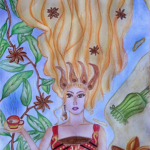Audrey Fitria Devani Kawilarang, Hana Rahmawati, Jeanie Kalina
The work entitled “Lady Pimpinella” is inspired by Bunga Lawang. Lawang or pekak flower is a flora originating from China. The name of lawang flower in Chinese is ba jiao or bat gok which means “eight horns”. In the 17th century AD, Lawang flowers were introduced in the European continent. In their home country it is usually used as a traditional herb and food spice. The lawang flower is a plant that likes cold and sub-tropical regions. This can be seen from its very wide distribution, including in Indonesia. This plant is known as a spice that produces a distinctive aroma. The unique shape is the characteristic of this flower so that it is easily recognized. The dried fruit of the lawang flower has a strong distinctive aroma, making it suitable as a spice to be mixed with ginger, cinnamon, and black pepper. The lawang flower is also often used for traditional drinks such as herbal medicine and tea drink mixes. Based on the historical and cultural values of the spices contained in lawang flower, the artist manually depicted Lady Pimpinella into a fashion illustration. The concept of the work depicts the figure of a princess wearing traditional clothes such as kemben holding a warm cup of tea containing lawang flowers inside. Lawang flower is implemented into the developed batik motif. The dominant colors of lawang flower is brown, black and red are the main color shades of the work to give it a traditional impression. The background of the object depicts the concept of parts of the Lawang Flower plant, from the leaves, shoots, to the fruit of the Lawang Flower. This fashion illustration is made to remember that the lawang flower is one of the typical Indonesian spices that has a distinctive fragrance, unique beauty and many benefits.



